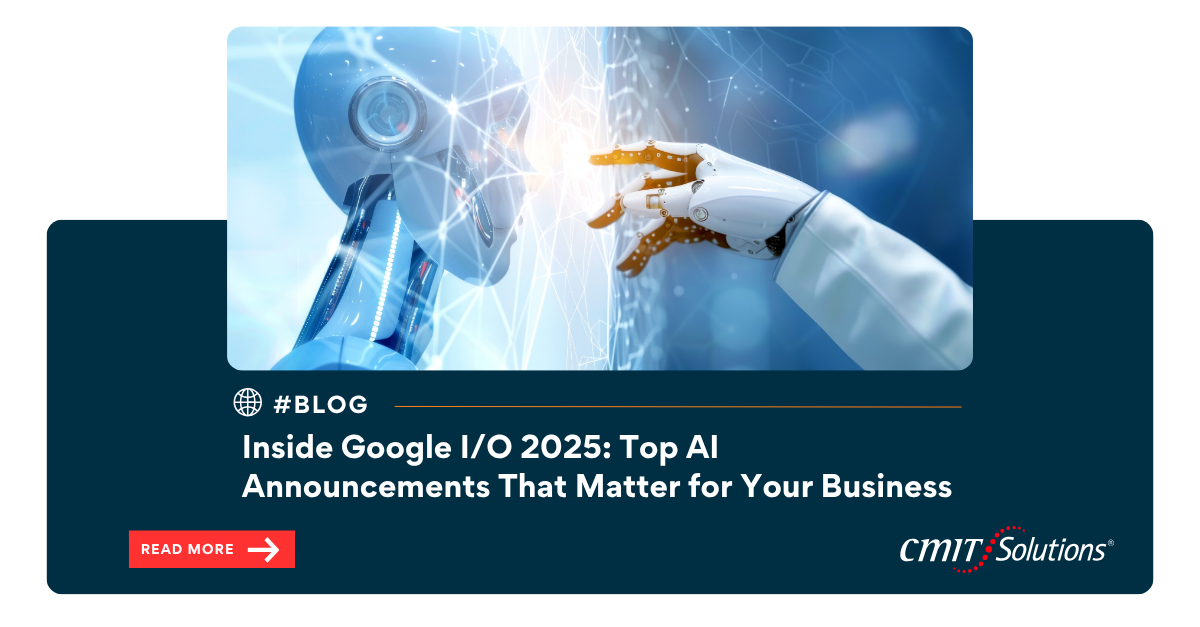Introduction: A Turning Point for AI-First Experiences
Google I/O 2025 proved to be more than a developer conference—it became a full-blown declaration of Google’s future direction. With artificial intelligence dominating every keynote and product reveal, the event signaled a shift not only in consumer technology but also in how businesses must prepare for an AI-first era.
From unveiling its most advanced AI model yet to showcasing practical tools like AI-powered email replies and live translation, Google reinforced its role as a key innovator in shaping enterprise technology. For organizations working with IT providers like CMIT Solutions of Oak Park, Hinsdale & Oak Brook, these developments are essential to understand. This blog unpacks 10 of the biggest announcements from Google I/O 2025 and explains how they could affect business IT strategies going forward.
1. Gemini 2.5 Pro & Flash Redefine AI Intelligence
Google’s Gemini AI model is now more capable than ever. Gemini 2.5 Pro introduces a feature called “Deep Think,” enhancing its reasoning to solve intricate problems like multistep code or math queries. Google says this model has improved across all metrics, topping the LMArena leaderboard with increased Elo scores.
Meanwhile, Gemini 2.5 Flash offers a faster and more cost-efficient option, delivering exceptional multimodal processing and coding support while consuming fewer tokens. For small businesses navigating between performance and budget, Flash may offer a high-value sweet spot.
With the rise of AI-driven systems, it’s worth exploring why cybersecurity compliance matters more than ever to protect AI-enhanced workflows.
Key Points:
- Deep Think allows deeper multi-step reasoning.
- Flash offers a lightweight, affordable alternative.
- Useful for budget-conscious small businesses.
2. Google Beam Launches: Next-Level 3D Video Calling
Project Starline has officially evolved into Google Beam. Designed to make remote communication feel in-person, Beam uses a six-camera system, AI processing, and light-field display technology to simulate realistic 3D video calls.
Companies like Deloitte and Salesforce are already investing in this experience, which features millimeter-accurate head tracking and 60 FPS performance. With partners like HP helping bring this hardware to market, the future of virtual meetings is immersive.
This shift toward more engaging virtual work aligns with the digital employee experience revolution, where engagement and communication must meet new standards.
Key Points:
- Provides ultra-realistic 3D video calling.
- Utilizes light-field displays and AI processing.
- Early enterprise adopters include Deloitte and Salesforce.
3. AI Ultra: The Boldest Subscription Yet
Google introduced AI Ultra, a $250/month subscription tier that offers early access to new AI tools, unlimited usage, and exclusive features like Deep Research. Subscribers also receive 30TB of cloud storage, YouTube Premium, and tools like Project Mariner.
Although expensive, this plan signals a trend toward AI exclusivity. High-end users and enterprises may benefit from early AI adoption, though others may wait for features to trickle down to general offerings.
It’s a reminder that evaluating ROI is critical. Check out why every business needs an IT assessment before adopting expensive AI tools.
4. Search Gets Smarter with AI Mode and Deep Search
Google Search is transforming into an interactive, conversational tool. The new AI Mode allows users to input complex, multi-part queries and continue follow-up interactions. Deep Search, a background capability, analyzes hundreds of related terms for richer context.
This is no ordinary update—it’s a reinvention of how people and machines interact with information.
For businesses, this underscores the importance of real-time responsiveness. Learn how network visibility keeps your data secure and agile.
Key Points:
- AI Mode transforms search into an interactive conversation.
- Deep Search improves query depth and relevance.
- Users now submit longer, more complex search questions.
5. Android XR and Smart Glasses Take Center Stage
Google announced Project Aura smart glasses powered by Android XR, a platform for mixed reality that supports voice, translation, 360° video, and integrated Gemini AI. Developed with Xreal and fashion brands like Warby Parker, this is Google’s most stylish and functional foray into wearables.
With applications in training, customer service, logistics, and AR navigation, smart glasses may finally break into the mainstream workplace.
This innovation resonates with why unified communication platforms are becoming smarter and more immersive.
6. Gmail Gets Personalized Smart Replies
Coming in July 2025, Gmail will feature AI-generated replies that reflect your tone and language. This personalization is based on past emails and files from Google Drive, with privacy controls in place.
Imagine replying to client inquiries with your usual phrasing—even while multitasking. While the concept may feel uncanny, the productivity gains are significant.
This enhancement aligns with email security best practices that ensure automation doesn’t compromise communication integrity.
7. Real-Time Translations Come to Google Meet
Google Meet now offers real-time translation, starting with English and Spanish. The translation engine retains tone and pacing, providing a more natural multilingual experience during video calls.
Global teams will find this especially useful for cross-border collaboration, multilingual client meetings, and inclusive internal communication.
As businesses grow internationally, multilingual tech tools are a strategic advantage.
Key Points:
- Live translation during Google Meet calls.
- Preserves tone and rhythm of the speaker.
- Aims to remove language barriers for teams.
8. Project Mariner: AI Agent With Multitasking Mastery
Project Mariner, Google’s personal AI assistant, is now capable of multitasking across up to 10 tasks simultaneously. From booking travel to comparing products, it can also learn tasks through demonstration.
This AI agent is integrated with Gemini API, supported by automation platforms like UiPath, making it ideal for IT automation and business process optimization.
Explore AI’s growing role in business strategy to see how such agents can support scalability.
9. Project Astra: Google’s Universal AI Assistant
Project Astra introduces a context-aware AI that can interpret your surroundings via your phone’s camera. From assisting with home repairs to identifying objects or translating signage in real time, Astra is a breakthrough in experiential AI.
Its real-time environment analysis could find applications in manufacturing, field support, or retail training.
To build a responsive tech stack, consider data observability tools that work in tandem with AI.
10. AI Visuals Evolve with Veo 3, Imagen 4, and Flow
Google enhanced its creative AI tools with:
- Veo 3: Generates video clips with audio, music, and dialogue
- Imagen 4: Creates photorealistic images with improved detail
- Flow: A mobile app that assembles AI video clips into longer scenes
These tools could empower marketers, educators, and designers to produce high-quality visual content quickly.
To protect this content, reinforce your infrastructure with robust data backup and disaster recovery.
Conclusion: What Google I/O 2025 Means for Your Business
Google I/O 2025 made one thing clear: AI is no longer a future trend—it’s the operating system of modern enterprise. Whether you’re intrigued by Gemini’s Deep Think mode or excited about Project Astra’s context-aware intelligence, these tools are shaping how we communicate, collaborate, and compute.
For businesses served by CMIT Solutions of Oak Park, Hinsdale & Oak Brook, staying competitive means not just knowing what’s new but acting on it. The integration of AI into email, search, video calls, and process automation offers endless potential. But these benefits only come with a strategic IT foundation.
So the question isn’t whether to adopt AI—but how fast you can adapt to it. And with CMIT by your side, you won’t just keep up—you’ll lead.
Let us help you audit, implement, and future-proof your AI-ready infrastructure today.






